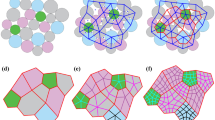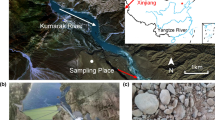Abstract
Oil and gas resources covered under gravel layer have had much attention. The mechanical behaviors and failure mechanism of conglomerate, main component of gravel layer, are still unclear for the complex distribution characteristics in gravel size, shape, and content. A numerical model considering gravel particles distributed randomly was established to study the effect of gravel distribution characteristics using a discrete element method. Results indicate that increasing the gravel size or content, or overlap** of the particles can reduce the number of independent gravel blocks, thus enhancing the heterogeneity of conglomerate and changing the failure types and crack development trend. The failure strength shows a parabolic trend with rising gravel content, while the elastic modulus increases linearly, causing the ability of specimen to resist deformation to improve. The mutual extrusion brings about the increase of failure strength rapidly and the reversal of peak strain and Poisson’s ratio when gravel content is over 70%. The cohesion and internal friction angle show a parabolic tendency, based on which the strength prediction model of conglomerate considering gravel content was established with high precision. This work provides a kind of numerical method for studying the physical and mechanical characteristics of the strongly heterogeneous rock considering the components.


















Similar content being viewed by others
Data availability
All data during the current study are available from the corresponding author on reasonable request.
References
Bai S (2015) Kuqa piedmont region drilling resistance characteristics and bit drilling optimization technology research. Yangtze University, **gzhou
Boyum BH (1961) Subsidence case studies in Michigan mines. In: Symposium on Rock Mechanics. University Park, Penn., USA, pp 19–57
Bratton J, Pratt H (1968) Two-dimensional finite difference calculations of dynamic in-situ response of layered geologic media to a large explosive load. In: The 10th U.S. Symposium on Rock Mechanics (USRMS). ARMA, Austin, Texas, pp 149–198
Cundall PA, Hart RD (1992) Eng Comput 9:101–108
Cundall PA, Strack ODL (1979) A discrete numerical model for granular assemblies. Geotechnique 29:47–65
Hou B, ** Y, Li S, Zeng C (2015) Failure mechanisms of borehole wall rocks in gravel beds with different grain sizes. Nat Gas Ind 35(11):66–70
Hou B, Zeng C, Chen D, Fan M, Chen M (2016) Prediction of wellbore stability in conglomerate formation using discrete element method. Arab J Sci Eng 42(4):1609–1619
International Society for Rock Mechanics (ISRM) (1978) Suggested methods for determining tensile strength of rock materials. Int J Rock Mech Min Sci Geomech Abstr 15(1):99–103
Itasca Consulting Group, Inc (2016) PFC (Particle Flow code in 2 and 3 Dimensions), version5.0 [User’s manual]. ICG, Minneapolis, MN
Jackson R, Gorski B, Gyenge M (1995) Geotechnical properties of rock. A database of physical properties of Canadian rock including both intact and residual strengths. Canada Communication Group, pp 15–91
** C (2017) Study on mechanical properties and fracture law of conglomerate reservoir. China University of Petroleum, Bei**g, Bei**g
Lei ST, Kaitkay P (2013) Distinct element modeling of rock cutting under hydrostatic pressure. Key Eng Mater 250:110–117
Li N, Zhang SC, Ma XF, Zou YS, Chen M, Li SH, Zhang YN (2017) Experimental study on the propagation mechanism of hydraulic fracture in glutenite formations. Chin J Rock Mech Eng 36(10):2383–2392
Liu G, Cai M, Huang M (2018b) Mechanical properties of brittle rock governed by micro-geometric heterogeneity. Comput Geotech 104:358–372
Liu XJ, **ong J, Liang LX, You XC (2018a) Rock mechanical characteristics and fracture propagation mechanism of sandy conglomerate reservoirs in Baikouquan Formation of Mahu Sag. **njiang Pet Geol 39(01):83–91
Luo SL, Ge HK, Wang JB, Zhou W, Shen YB, Liu PY, Liu JT (2021) Numerical simulation study on the crack propagation of conglomerate. R Soc Open Sci 8(7):1–20
Neng Y, **e HW, Sun TR, Lei GL, Xu LL (2013) Structural characteristics of Keshen segmentation in Kelasu structural belt and its petroleum significance. China Pet Explor 18(2):1–6
Potyondy DO (2015) The bonded-particle model as a tool for rock mechanics research and application: current trends and future directions. Geosystem Eng 18(1):1–28
Qu JH, Zhang L, Wu J, You XC (2017) Characteristics of sandy conglomerate reservoirs and controlling factors on physical properties of Baikouquan Formation in the Western Slope of Mahu Sag, Junggar Basin. **njiang Pet Geol 38(1):1–6
Rogers JP (2007) New reservoir model from an old oil field, Garfield conglomerate pool, Pawnee County, Kansas. AAPG Bull 91:1349–1365
Sakram MS (2010) Physical and numerical investigation of conglomeratic rocks. University of New South Wales, New South Wales Australia Sydney
Satoru K, Hiroshi I, Kazuhiro K (2010) Evaluation on scale effect of conglomerate core sample and disturbance by core sampling. J Jpn Soc Eng Geol 39(4):391–400
Schmidt GA, Pemberton SG (2014) Stratigraphy and paleogeography of a conglomeratic shoreline, the Notikewin Member of the Spirit River Formation in the Wapiti Area of Westcentral Alberta. Bull Can Petrol Geol 52(1):57–76
Shafiei A, Dusseault MB (2008) Geomechanical properties of a conglomerate from Iran. In: The 42nd US Rock Mechanics Symposium and 2nd U.S.-Canada Rock Mechanics Symposium. ARMA, San Francisco, pp 08–053
Teng XQ, Chen M, Yang P, Li N, Zhou B (2016) Whole well ROP enhancement technology for super-deep wells in Kuqa foreland basin. China Pet Explor 21(1):76–88
Teng XQ, Liu HT, Li N, Wang TB, Ru DJ, Dong R (2021) Difficulties and technical countermeasures for automatic vertical drilling in ultra-deep wells in the Bozi Block of the Tarim Basin. Pet Drill Techniques 49(01):11–15
Tian J, Liu HT, Teng XQ, Cai ZZ, Zhang H, Cao LH (2019) Geology-engineering integration practices throughout well lifecycle in ultradeep complex gas reservoirs of Kelasu tectonic belt Tarim Basin. China Pet Explor 24(02):165–173
Wang YM, Liang HJ, Li G, Qin LP, Jia HJ, Zeng YQ, Zhang Z (2012) Characteristics of gravel layer in DB block Tarim and it’s affection of fasten drilling. **njiang Geol 30(1):113–115
Yan Q, Lei HY, **an BZ, Wang J, Luo ZH, Yang Z, He J, Niu J, Pu Q (2020) Influence of source rock properties on the development of authigenic chlorite in conglomerate reservoirs and its significance for oil and gas reservoirs, a case study from the Lower Urhe Formation in the Mahu Depression, Junggar Basin. Acta Sedimentol Sinica 38(02):367–378
Zhang DR, Wen T, Pu L, Chi J, Zhou XJ, Liang HJ, Zhao CT (2020) Pilot test on the ROP improvement BHA of vertical drilling tool & screw rod with equal wall thickness: a case study on Well Keshen A in the high-steep structure of Kuqa piedmont area. Oil Drill Prod Technol 42(06):684–690
Zheng ZD (2016) ROP enhancement techniques in ultradeep exploratory wells in the piedmont area of Tarim Basin. Northeast Petroleum University, Daqing
Funding
The work of this study was supported by the National Key Research and Development Program of China (2021YFE0111400); the Major Project of CNPC (ZD2019-183-005); Project of Graduate Innovation of China University of Petroleum (East China) (YCX2020032).
Author information
Authors and Affiliations
Corresponding author
Ethics declarations
Competing interests
The authors declare that they have no known competing financial interests or personal relationships that could have appeared to influence the work reported in this paper.
Additional information
Responsible Editor: Murat Karakus
Rights and permissions
Springer Nature or its licensor (e.g. a society or other partner) holds exclusive rights to this article under a publishing agreement with the author(s) or other rightsholder(s); author self-archiving of the accepted manuscript version of this article is solely governed by the terms of such publishing agreement and applicable law.
About this article
Cite this article
Wei, J., Liao, H., Huang, B. et al. Effect of the random distribution of gravel particles on the mechanical behaviors of conglomerate. Arab J Geosci 16, 485 (2023). https://doi.org/10.1007/s12517-023-11565-0
Received:
Accepted:
Published:
DOI: https://doi.org/10.1007/s12517-023-11565-0




